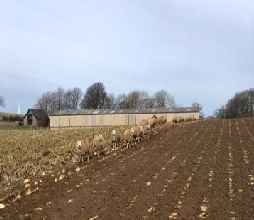Utilisation of Forage Crops
24 September 2018 There have been many people who have sown a catch crop to fill the forage gap this autumn and winter. It is essential that these forage crops are utilised appropriately to ensure maximum animal performance and utilisation of the crop.
There have been many people who have sown a catch crop to fill the forage gap this autumn and winter. It is essential that these forage crops are utilised appropriately to ensure maximum animal performance and utilisation of the crop.
Forage crops have a high energy (stubble turnips 11ME (MJ/kg DM)) and protein content (stubble turnips 17-18ME (MJ/kg DM)), with readily digestible carbohydrate, but these are low in fibre, so it is essential that fibrous forage is offered ad lib to animals grazing forage crops.
Some key tips for utilising forage crops:
- The transition on to forage crops is key, animals should be put on to crop with a full stomach and built up by another hour or twos access a day.
- The intake from the forage crop should be a maximum of 70% of the animals daily dry matter intake. With the other 30% being made up of fibrous forage. Overfeeding of brassica crops can lead to reduced intake and health issues (goitre, nitrate poisoning, bloat, etc.)
- Minerals/trace elements should be offered, with many forage crops being deficient in elements such as phosphorus, selenium, etc.
- The crop should be grazed behind a long narrow fence to increase utilisation and prevent wastage from trampling.
- The daily allocation (how far to move the fence) should be calculated for the crop (see calculating daily requirement article).
- Check the condition score of animals before putting them on to crop, anything too fat or too lean should not graze the crop.
- Check feet, any lame animals should be removed and treated to prevent contamination of the highly stocked pasture.
- Ensure older animals have the teeth to graze the crop.
- It is an idea to belly clip lambs prior to grazing a forage crop to assist with keeping the animals clean.
- Ensure there is adequate run back and water for the animals, which don’t pose an environmental or erosion risk.
Kirsten Williams, kirsten.williams@sac.co.uk
Sign up to the FAS newsletter
Receive updates on news, events and publications from Scotland’s Farm Advisory Service
